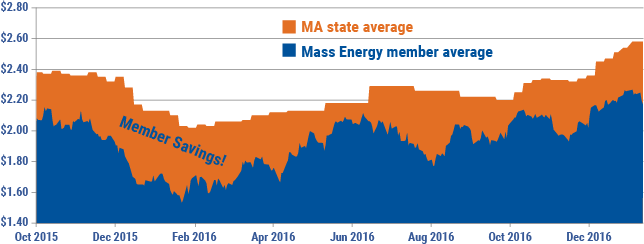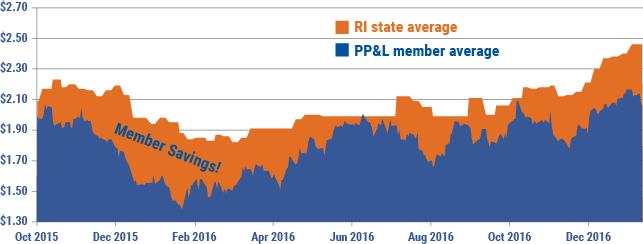
After last winter’s relative warmth and Mass Energy/PP&L prices mostly under $2 per gallon, this year we’re experiencing colder weather and somewhat higher prices. Both the colder weather and today’s prices are still lower than ‘normal’ by historical standards. Here’s our take on what we see happening in the oil markets.
Despite being colder than last season to date, we’re still running a bit warmer than ‘normal’ for degree days. Degree days are a great predictor of heating oil use and people in the oil industry count them religiously.
You may have noticed that oil prices through our discount heating oil program have been in the range of $2.15 to $2.25 for the last month or so. But as this is written, the average price paid in the market is about 30 cents higher than what our members are paying through our program. So, at this time of year when oil is a necessity, our members are saving real cash.
MA Heating Oil Price Graph

RI Heating Oil Price Graph

Experts point to the announced OPEC production cut as a reason for why prices are higher than last year. This is the first month that we’ll actually see if OPEC cuts production, so we’ll see how that works out. But, many of those experts are also suggesting that today’s prices may be the peak for the short term.
For one thing, inventories of heating oil in New England are at a five-year high for this time of year. That bodes well in case we hit a cold snap. When inventories are high, a blast of Artic air might cause us to use more oil but prices will be held somewhat in check.
Thinking longer term, oil producers in the US have figured out how to produce oil through horizontal fracking at lower prices than many thought possible a few years ago. What this means is that if crude oil prices rise to, say, $60 per barrel, production will increase sufficiently to keep prices from going much above that. For this reason, we do not envision circumstances that could cause heating oil or gasoline prices to reach the $3 per gallon level again. At that level, not only do producers ramp up, but consumers can easily find alternatives, whether that means weatherization, heat pumps, or electric cars.
So keep warm and remember the best way to save money on energy is to use less of it. The cheapest gallon or electron is the one you don’t use. While this year will certainly cost more than last, it will still be among the lowest cost heating seasons over the past ten years.





Comments